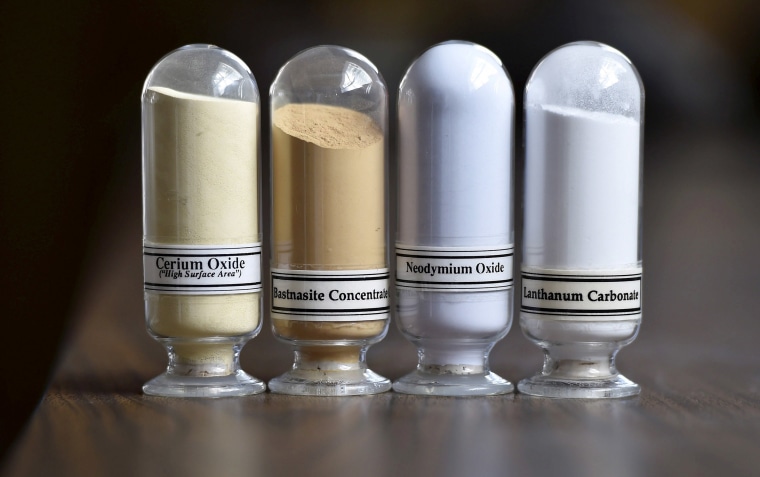Rare earth minerals are a common part of people's lives — and their futures.
If you have a smartphone or computer, own a flat-screen TV, drive a hybrid car or use a myriad of other high-tech devices, you'll no doubt come into contact with these elements — mined from the earth's crust and supplied predominantly by China — countless times a day.
But they are also used in obscure but powerful ways that ensure some of the biggest companies in the world can keep churning out those products.
Now, rare earths have become a bargaining chip in the expanding trade war between China and the United States, which escalated after the Trump administration placed Huawei, the world's largest supplier of telecommunications equipment, on a blacklist that imposed some restrictions on trading with American companies.
The importance of China's rare earths to the U.S. is one of many examples of how the two countries' tech industries have grown intertwined over the years — and why the escalating tension has experts concerned about the long-term impact of an economic decoupling.
Why are rare earths important?
Rare earth minerals are a crucial component of products that cut across the U.S. economy, not only in the tech sector but in the energy industry as a catalyst for oil refineries and in wind turbines, and in the automobile industry for manufacturing electric vehicle motors.
Despite their name, rare earths aren't all that rare. The U.S. Geological Survey describes them as a "relatively abundant group" of 17 chemical elements. What makes them unusual, however, is that they're difficult to extract in high concentrations from the ground.
The elements' names, which include cerium, promethium, scandium, might sound like something out of science fiction, but each one can be used for a variety of purposes — from making magnets, batteries and lights, to glass production and the cooling of nuclear rods.
The U.S. military also depends on rare earths for the construction of equipment used in satellites, lasers, jet engines, radar and sonar systems, and other sophisticated machinery.

Where does China come in?
From the 1960s to the '80s, the U.S. was the global leader in rare earth mineral production based out of a mine in California, which later closed.
But China quickly gained ground in the '90s, and is home to more than 30 percent of the world's rare earth reserves. By 2017, China accounted for roughly 80 percent of the world's rare earth production, according to the U.S. Geological Survey. Other countries, including India, Brazil and Australia, share a smaller output.
The U.S. imported about $160 million worth of basic rare earth materials last year, mainly from China.
Has China ever exploited its rare earths for political gain?
In 2010, Japan accused the Chinese government of purposefully halting its supply of rare earth minerals — seen as retaliation after Japan detained a Chinese fishing trawler captain who was found in waters under dispute by the two nations.
Japan counted on the rare earths for a number of uses, including the production of its hybrid cars, solar-panel glass and battery packs. Major manufacturers such as Toyota and Panasonic were disrupted by the blockade, according to reports.
The diplomatic dispute highlighted how much other countries have counted on China and how it remains a dominant and integral player in many industrial supply chains.
The U.S., Japan and Europe complained in 2010 that limits imposed on rare earth and metals exports were driving up prices and gave Chinese companies an unfair competitive edge.
In 2014, the World Trade Organization ruled that China could not impose export limits, which Beijing said was only being done to ease pollution caused by mining and to conserve its resources, Reuters reported.
Are rare earths at stake in this trade war?
China's President Xi Jinping may have tipped his hand last week when he toured a region of China that calls itself a "rare earths kingdom."
The visit, which some analysts saw as a show of force of China's dominance in the rare earths arena, set off concerns that Beijing may be pushing back against Washington's tariffs on Chinese imports by choosing to ban exports of the minerals.
Hu Xijin, the editor of The Global Times, a newspaper owned by the Chinese Communist Party, followed up in a tweet that the Chinese government was "seriously evaluating" the need to halt rare earth exports.
The Chinese Foreign Ministry, however, has been less forthcoming about what message was being sent.
Large American companies, including Lockheed Martin and Apple, have products that rely on rare earths.
In the case of Apple, its iPhones — the majority of which are made at a Foxconn factory in China — use the metals for its cameras, speakers and other key parts. While it's unclear what a rare earths ban might mean for the tech giant, analysts have expressed anxiety that it could disrupt production and affect prices.
Other American manufacturers also have production in China, while other U.S.-based companies import products, such as magnets, that already incorporate the rare earth elements.

